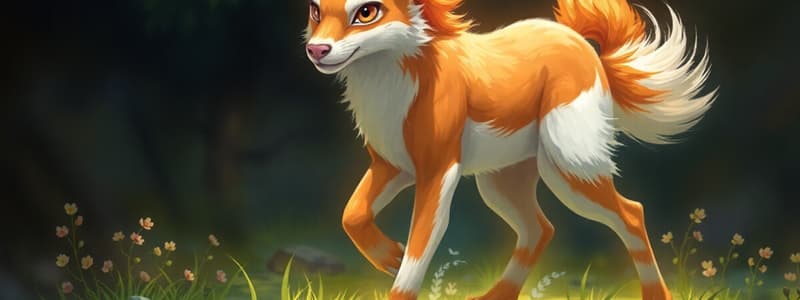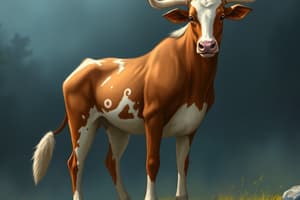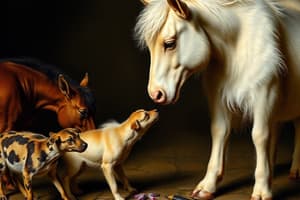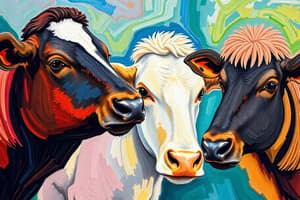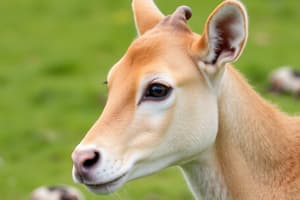Podcast
Questions and Answers
Which of the following best describes domestication?
Which of the following best describes domestication?
- The process whereby a population of living organisms is changed at the genetic level through selective breeding. (correct)
- The process of training animals to perform tricks.
- The process of keeping animals as pets.
- The process of moving wild animals to a farm.
Cats, dogs, and cows are examples of domestic animals.
Cats, dogs, and cows are examples of domestic animals.
True (A)
Name two common changes in traits that occur due to domestication.
Name two common changes in traits that occur due to domestication.
Tameness and floppy ears
_____ glands are associated with tameness in domesticated animals.
_____ glands are associated with tameness in domesticated animals.
What was the primary objective of Belyaev's fox experiment?
What was the primary objective of Belyaev's fox experiment?
In Belyaev's fox experiment, foxes were selected based on their physical characteristics, not temperament.
In Belyaev's fox experiment, foxes were selected based on their physical characteristics, not temperament.
What percentage of foxes in Belyaev's initial experiment were classified as 'extremely reactive'?
What percentage of foxes in Belyaev's initial experiment were classified as 'extremely reactive'?
The breeding criteria for Belyaev's foxes included assessing the _____ distance.
The breeding criteria for Belyaev's foxes included assessing the _____ distance.
Which of the following hormones is NOT directly mentioned in the text as being reduced in the release of stress hormones related to tameness?
Which of the following hormones is NOT directly mentioned in the text as being reduced in the release of stress hormones related to tameness?
Catecholamines, such as epinephrine and norepinephrine, regulate the duration of neonatal development.
Catecholamines, such as epinephrine and norepinephrine, regulate the duration of neonatal development.
According to the neural crest hypothesis, what happens to the size of the neural crest during domestication?
According to the neural crest hypothesis, what happens to the size of the neural crest during domestication?
According to the neural crest hypothesis, a reduction in the population of cells derived from the neural crest results in _____ because of reduced stress hormone synthesis.
According to the neural crest hypothesis, a reduction in the population of cells derived from the neural crest results in _____ because of reduced stress hormone synthesis.
Match each animal with its pathway to domestication:
Match each animal with its pathway to domestication:
Which pathway of domestication starts with 'Habituation'?
Which pathway of domestication starts with 'Habituation'?
The prey domestication pathway involves a transition from habituation to partnership.
The prey domestication pathway involves a transition from habituation to partnership.
Name two characteristics of extensive animal systems.
Name two characteristics of extensive animal systems.
_____ and _____ are examples of animals typically raised in extensive systems.
_____ and _____ are examples of animals typically raised in extensive systems.
Which of the following is a characteristic feature of intensive animal systems?
Which of the following is a characteristic feature of intensive animal systems?
Beef cattle are typically raised in intensive production systems.
Beef cattle are typically raised in intensive production systems.
What are the three main sector types mentioned in the context of animal production systems?
What are the three main sector types mentioned in the context of animal production systems?
In the context of beef production, _____ refers to managing animals with forage/pasture diets and slow growth.
In the context of beef production, _____ refers to managing animals with forage/pasture diets and slow growth.
What is a 'heifer'?
What is a 'heifer'?
A steer is a sexually mature, uncastrated male.
A steer is a sexually mature, uncastrated male.
How long is the gestation period for cows (in days)?
How long is the gestation period for cows (in days)?
A mature female pig is called a _____.
A mature female pig is called a _____.
What term refers to giving birth to piglets?
What term refers to giving birth to piglets?
Modern swine production in Canada involves minimal confinement throughout the pigs' lives.
Modern swine production in Canada involves minimal confinement throughout the pigs' lives.
Approximately what is the average litter size for sows in modern swine production?
Approximately what is the average litter size for sows in modern swine production?
The process of removing young ones from their mother in pig production is called _____.
The process of removing young ones from their mother in pig production is called _____.
The process of stabilizing the price of milk through production licenses is called what?
The process of stabilizing the price of milk through production licenses is called what?
Calves are born with immunoglobulins in their bloodstream.
Calves are born with immunoglobulins in their bloodstream.
What is the term for the passive immunity that calves receive from their mother's first milk?
What is the term for the passive immunity that calves receive from their mother's first milk?
_____ are Y-shaped proteins that bind to bacteria and viruses to help prevent disease.
_____ are Y-shaped proteins that bind to bacteria and viruses to help prevent disease.
Which of the following is the "Foundation of the Beef Industry?"
Which of the following is the "Foundation of the Beef Industry?"
Feed costs are the least variable cost in beef production.
Feed costs are the least variable cost in beef production.
What are the three factors Canada's Traceability Program is based on?
What are the three factors Canada's Traceability Program is based on?
Cattle must have individual ID and _____ ID in order to leave a property.
Cattle must have individual ID and _____ ID in order to leave a property.
Name two dominant breeds of cattle.
Name two dominant breeds of cattle.
What condition is commonly associated with the Overo Pinto horse coat color?
What condition is commonly associated with the Overo Pinto horse coat color?
Which coat color in horses is associated with an increased risk of melanomas?
Which coat color in horses is associated with an increased risk of melanomas?
Flashcards
What is domestication?
What is domestication?
The process of genetic change through selective breeding to accentuate desirable traits.
Examples of domestic animals
Examples of domestic animals
Cats, dogs, horses, and cows.
Degrees of domestication
Degrees of domestication
Wild (fight or flight), Tamed, Semi-domesticated, Domesticated
Common traits changed in domestication
Common traits changed in domestication
Signup and view all the flashcards
Belyaev's Fox experiment
Belyaev's Fox experiment
Signup and view all the flashcards
Tameness
Tameness
Signup and view all the flashcards
Hormones involved in tameness
Hormones involved in tameness
Signup and view all the flashcards
Neural crest hypothesis
Neural crest hypothesis
Signup and view all the flashcards
Domestication's effect on neural crest size
Domestication's effect on neural crest size
Signup and view all the flashcards
Commensal pathway
Commensal pathway
Signup and view all the flashcards
Prey pathway of domestication
Prey pathway of domestication
Signup and view all the flashcards
What is an Extensive animal system?
What is an Extensive animal system?
Signup and view all the flashcards
What is an Intensive animal system?
What is an Intensive animal system?
Signup and view all the flashcards
Examples of extensive systems
Examples of extensive systems
Signup and view all the flashcards
Examples of intensive systems.
Examples of intensive systems.
Signup and view all the flashcards
Sector types in beef production
Sector types in beef production
Signup and view all the flashcards
Definition of a cow
Definition of a cow
Signup and view all the flashcards
Definition of heifer
Definition of heifer
Signup and view all the flashcards
Definition of Bull
Definition of Bull
Signup and view all the flashcards
Definition of steer
Definition of steer
Signup and view all the flashcards
Definition of calf
Definition of calf
Signup and view all the flashcards
Gestation period of a cow
Gestation period of a cow
Signup and view all the flashcards
Definition of sow
Definition of sow
Signup and view all the flashcards
Definition of gilt
Definition of gilt
Signup and view all the flashcards
Definition of boar
Definition of boar
Signup and view all the flashcards
Definition of barrow
Definition of barrow
Signup and view all the flashcards
Definition of piglet
Definition of piglet
Signup and view all the flashcards
What is Farrowing?
What is Farrowing?
Signup and view all the flashcards
What is supply management in Canada?
What is supply management in Canada?
Signup and view all the flashcards
What is Quota (dairy)?
What is Quota (dairy)?
Signup and view all the flashcards
Why is colostrum important?
Why is colostrum important?
Signup and view all the flashcards
Animal identification
Animal identification
Signup and view all the flashcards
Dominant cattle breeds
Dominant cattle breeds
Signup and view all the flashcards
Poultry terminology
Poultry terminology
Signup and view all the flashcards
Why is chicken the most consumed meat?
Why is chicken the most consumed meat?
Signup and view all the flashcards
Horse colors with disadvantages
Horse colors with disadvantages
Signup and view all the flashcards
Detrimental effects of specialization for horses
Detrimental effects of specialization for horses
Signup and view all the flashcards
Origin of domestic pig
Origin of domestic pig
Signup and view all the flashcards
Major Canadian swine breeds
Major Canadian swine breeds
Signup and view all the flashcards
Terms related to animal lifecycle
Terms related to animal lifecycle
Signup and view all the flashcards
Study Notes
Lecture 1: Domestication and Animal Traits
- Domestication involves genetically changing a population of organisms through selective breeding to enhance traits beneficial to humans
- Domestic animals include common pets and livestock like cats, dogs, horses, and cows
Degrees of Domestication
- Wild animals exhibit a "fight or flight" response
- Tamed animals show some reliance on humans
- Semi-domesticated animals have a human-animal relationship
- Domesticated animals are fully reliant on humans
Common Changes in Domesticated Traits
- Tameness is linked to adrenal glands
- Coat color involves melanocytes
- Reduced skull size relates to chondrocytes
- Reduced teeth size involves odontocytes
- Morphological alterations can occur
- Floppy ears can develop
Belyaev's Fox Experiment
- Foxes were selected based on temperament
- The experiment began with 465 foxes
- Aimed to replicate wolf domestication into modern dogs
- Initial behavioral distribution: 30% extremely reactive, 40% moderately reactive, 20% fearful, 10% quiet & exploratory
- Breeding criterion was flight threshold distance
Tameness and Hormones
- Tameness is characterized by reduced stress hormone release
- It leads to reduced fight-or-flight response
- It causes decreased reactivity to new situations
- Hormones are produced by adrenal glands
- Long-term hormones include glucocorticoids like cortisol, regulating neonatal development
- Short-term hormones include catecholamines like epinephrine and norepinephrine
- Domestic animals typically show a reduction in these hormones compared to wild animals
Neural Crest Hypothesis
- Genetic changes in neural crest cells result in domestication traits
- Domestication involves a reduction in the size of the neural crest
- It reduces the population of cells derived from the neural crest
- It causes tameness due to reduced stress hormone synthesis
- Cells producing these hormones originate from the neural crest
- Fewer neural crest cells present results in domestication syndrome
Wolf Domestication
- Wolves with shorter flight distances benefited from human food waste, providing a competitive advantage
- These wolves preferentially bred with each other
- Development of domestication syndrome occurred
Domestication Pathways
- Commensal pathway progresses from habituation to partnership and then directed breeding
- Prey pathway goes from prey to game management, herd management, and directed breeding
Lecture 2: Animal Systems and Production
Extensive vs. Intensive Animal Systems
- Extensive systems use minimal capital inputs and unprocessed, low-nutrient, high-fiber diets, with minimal confinement and handling
- Beef cattle, sheep, and goats are examples of animals raised in extensive systems
- Intensive systems use significant capital inputs, processed, nutrient-dense diets, and confinement production to achieve economies of scale
- Pork, dairy, and poultry are examples of animals raised in intensive systems
Sector Types
- Cow-calf operations represent primary extensive production, utilizing pasture and rangeland
- Backgrounding/stocker operations manage animals with forage/pasture diets, resulting in slow growth
- Feedlot/finishing operations use intensive production with primarily concentrate diets
- Packing sector relates to intensive production, specifically with feedlots having some pasture
Animal Lifecycle Terms
- Cow is a mature female
- Heifer is a young female
- Bull is a sexually mature uncastrated male
- Steer is a castrated male before sexual maturity
- Calf is a neonatal animal up to 5 months of age
- Gestation period lasts 283 days, with 82 days to get pregnant post calving
Pork Terms
- Sow is a mature female pig
- Gilt is an immature female pig before its second pregnancy
- Boar is a mature male pig
- Barrow is a castrated male pig
- Piglet is a neonatal pig before weaning
- Farrowing is the act of giving birth to piglets
Modern Swine Production
- Modern swine production involves raising pigs in total confinement throughout their lives
- Biosecurity is very important on commercial farms
- Limited visitors are allowed
- Breeding is done through artificial insemination
- Gestation takes 3 months, 3 weeks, and 3 days
Farrowing Management
- Sows are kept in individual crates
- Average litter size is 15 piglets
- The average birth weight is 1.2 kg
- Colostrum intake is critical in the first 6 hours
- Most sows have 12 teats
Weaning
- Weaning is abrupt
- Piglets are moved to a nursery
- Piglets transition from milk to solid feed
- Piglets are mixed with other piglets
- Piglets are 21-28 days old at weaning
Grow-Finish Phase
- Piglets spend after 5 weeks in the nursery
- Piglets spend this time housed in large groups
- Diets are changed as pigs mature
- Pigs are ready for market in 15 weeks, weighing 125 to 130 kg
Dairy Production
- The dairy lifecycle progresses from lactation cycle to lifespan to calves
- Parturition and milk fever in cows require them to mobilize large amounts of calcium from the skeleton
- Insufficient calcium can cause muscle tremors, staggering, lying flat, heart failure and death
- Treatment involves intravenous calcium
Supply Management
- Milk production is designed to meet Canadian demand
- Limited exports and imports of milk and milk products happen
- The quantity of milk required is established for each province
- Quota is a license to produce up to a set amount of milk
- A national marketing agency determines production amounts and sets provincial production quotas
- Producers are guaranteed minimum prices for their products
- High tariffs make imported dairy more expensive
Importance of Colostrum
- Calves are born without immunoglobulins in their bloodstream
- The newborn small intestine absorbs immunoglobulins into the blood for the first 24 hours after birth, called passive immunity
- Antibodies are Y-shaped proteins that bind to bacteria and viruses to help prevent disease
Lecture 3: Beef Industry and Forages
North American Beef Industry
- The beef industry is split into production sectors, including cow-calf, backgrounding, feedlot, and packer operations
- There are over 90,000 beef producers
- The Canadian beef industry includes 15 million cattle and calves
- Majority are family fun operations
Forages in Cow-Calf Management
- Forages are pastures, hay, straw, and silage considered the foundation of the beef industry
- Feed is the highest variable cost in beef production
- Forages focus on energy, protein, minerals, vitimins and water
Canada's Traceability Program
- This is based on animal identification with radio-frequency tags
- It requires individual and premise IDs for cattle to leave a property
- Premise identification and animal movement are tracked
Cattle Breed Variations
- Dominant breeds include Angus, Simmental, Hereford, Charolais, and Limousin
- Breeds vary in color, carcass quality, behavior, frame size, and feed efficiency
Weaned Calf Sales
- Calves are sold in groups through auction mart to feedlot buyers
- Internet/video sales are used
- Forward contracts with feedlots involve delivering calves for a pre-arranged price, eliminating sale barns
Lecture 4: Poultry and Supply Management
Poultry Terminology
- Broiler refers to meat chickens
- Layer refers to table egg production chickens
- Rooster refers to male chickens
- Tom refers to male turkeys
- Hen refers to female turkeys or chickens
Chicken Consumption
- Chicken is the most consumed meat because Canada uses a supply management system, producing as much as is consumed
Poultry Supply Management
- This features family farms in Canada
- It means producers receive a steady income
- Vaccines are available, but use is subject to politician’s approval
- More than 1000 boilers is considered commercial
Advantages of Poultry Supply Management
-
Assures steady income for producers
-
Sustains predictable supply without surplus
-
Allows support added welfare initiatives
-
Allows boards to provide say in animal welfare practices
Disadvantages of Poultry Supply Management
- Products are more expensive
- Future producers must purchase quota
Lecture 5: Horse Domestication and Breeding
Horse Evolution and Domestication
- Equus evolved in North America before migrating to Eurasia
- They spread across the Eurasian steppes
- Horses were initially hunted for food
- Raised in captivity, domestication commenced
Horse Use Through History
- Horses were first used for carrying and hauling
- Later, they aided affective are tactics
- Subsequently they were used for riding
Coat Color Disadvantages
- Certain colors have selective disadvantages in the wild
- Negative pleiotropic effects result, where a single gene affects multiple systems
- Grey: Melanomas
- Silver: MCOA- eye disorder
- Leopard Spotting: CSNB
- Overo Pinto: OLWFS
- Splashed white: Deafness
- Overo: Deafness
- White: Embryonic lethal
- Roan: Embryonic lethal
Detrimental Effects of Specialization
- Breeding for small size- dwarfism
- Breeding for heavily muscled quarter horses- periodic paralysis
- Breeding for speed- propagate fragility
- "Popular sire"- disequilibrium between detrimental genes and performance genes
Lecture 6: Origin and Production of Domestic Swine
- Domestic pigs were likely domesticated in China (490 B.C.) and England (800 B.C.)
- The latin name for pigs is "Sus scrofa domesticus"
Common Swine Breeds
- Yorkshire makes up 42% of herds
- Landrace makes up 32% of herds
- Duroc makes up 25% of herds
- Others include Hampshire, Lacombe, Pietrain, Berkshire
Terms Related to Swine Production
- Swine = pig
- Pork = pig meat
- Sow = mother pig
- Gilt = of breeding age, not having had piglets
- Weaning = removing young from mother
- Hog = pig ready to be processed
- Process/harvest = slaughter for meat
- Boar = adult male pig for breeding
- Farrowing = the act of parturition in pigs
Pork Production in Saskatchewan
- SK is responsible for 8.5% of all pig production
- SK is the 5th largest producer in hogs
How swine operations are improving
- Advances in technology and transportation
- Economies of scale
Lecture 7: Trends and Effects of Pet Domestication
Ownership
- Cat ownership is > than dog ownership
- There are 8.5 million cats as pets
- There are 7.9 million dogs as pets
Pet Costs
- Pet cats cost ~ $2,542
- Per dogs cost ~ $2,500 + $1,000
Pet Store Trends
- Ontario had 770 pet stores in 2021
- Brick and mortar stores are declining
- Online purchases are increasing
Impacts from Domestication on Characteristics of Dogs Vs Cats
- Dogs started with hunter-gatherer societies, descended from unknown wolf, started as mutual co-existence then companionship
- Resulted in altered appearance and behavior
- Resulted in increased ability to digest carbohydrate-rich diet through amylase enzyme increase Cats are more recent
- cats are much moreso independent compared to dogs
- Domestication has not changes how cats look/behave -Easily revert to feral
- Diet/metabolism untouched from wild
Pet ownership benefits
- Social support
- Companionship
- Mental health
- Motivates exercise
- Assisted activities
- Empathy, social skills
Pet ownership risks
- Infections, parasites
- Allergies
- Bites, injury
- Financial burden
- Burden of loss
- Neglect
Animal Assisted Therapy vs Activities
Animal assisted therapy
- Part of treatment for people who need social, emotional, physical therapy, or are cognitively challenged
- Includes goals, scheduled events, and individual treatment
- Administered by trained professionals in detail
Animal Assisted Activities
- Casual activities involving pets and peoples
- Low or no specificity; volunteer based
- Flexible in duration
Lecture 8: Dairy Cow Management
- Milk supply management: production meets the needs of Canadians; limits on exports/imports and volume for each province
- Artificial insemination, a calf annually, housed calves, feed milk replacer, shift to lean growth, breed @ 13-15 months, calving at 24
Aspects of dairy cattle management
- Colostrum and passive transfer
- Changes in milk yield
- Cow comfort
- Mammary gland
What good cows need to succeed:
- Great place
- Adequate nutrition
- Calm handling
Mammary glands
- Use it or lose it policy means stimulating it's development
- Regular milking during lactation stimulates cell development
- Increased cells development has carry over effects
- Nutrient demand increases tremendously
Lecture 9: Indigenous Principles for Sustainable Aquaculture
Indigenous Similarities and Differences
- There are distinct cultures including First Nations, ‘Metis’, and ‘Inuit’ here in Canada
- Each of these has different cultures, histories, practices, and beliefs
Indigenous Principles
- Transparency and First Nations Inclusiveness
- Social responsibility
- Environmental responsibility
- Economic responsibility
Aboriginal and nonAboriginal culture aspects:
- Unique culture
-Unique history, ancestral connection
-May have mistrust of conventional science
-Aquatic rights
- Create jobs
- Higher prices
Studying That Suits You
Use AI to generate personalized quizzes and flashcards to suit your learning preferences.
